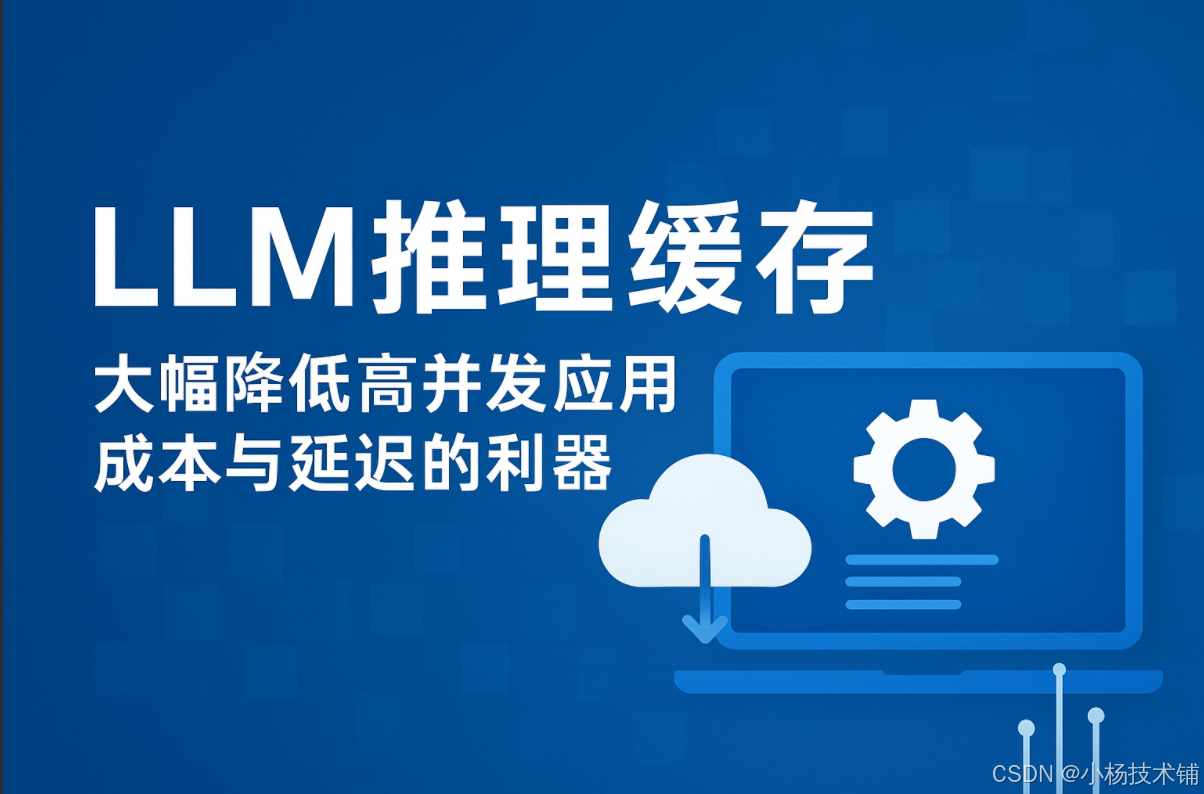大型语言模型处理重复查询时,如何节省90%的API成本?推理缓存是关键解决方案!
引言:为什么需要LLM推理缓存?
在当前AI应用蓬勃发展的时代,大型语言模型(LLM)已广泛应用于聊天机器人、客户支持、代码助手等场景。这些应用通常每天需要处理数百万个查询,其中许多问题都是重复或相似的。
想象一下客户服务机器人的典型场景,每天都有成千上万的用户提出类似问题:
-
"你们的退款政策是什么?"
-
"如何重置密码?"
-
"交货时间是多少?"
如果每个查询都直接调用LLM,不仅会不必要地消耗API预算,还会增加响应延迟。推理缓存正是解决这一问题的关键技术,它可以存储常见问题的结果并重复使用,显著提升系统效率。
环境设置与基础依赖
在开始实现之前,我们先配置基础环境:
python
!pip install openai numpy
import os
import time
import numpy as np
from openai import OpenAI
# 设置OpenAI API密钥
os.environ["OPENAI_API_KEY"] = "sk-your_api_key_here"
client = OpenAI()基础实现:从简单LLM调用开始
首先,我们实现一个基础的LLM调用函数,并测量其响应时间:
python
def ask_llm(prompt):
"""基础LLM调用函数,包含时间测量"""
start = time.time()
response = client.chat.completions.create(
model="gpt-4o-mini",
messages=[{"role": "user", "content": prompt}]
)
end = time.time()
print(f"响应时间: {end - start:.2f}秒")
return response.choices[0].message.content
# 测试基础调用
print("测试基础LLM调用:")
result = ask_llm("What is your refund policy?")
print(f"响应内容: {result}\n")输出示例:
响应时间: 2.81秒
响应内容: As an AI language model, I don't have a refund policy since I don't...
问题暴露:重复查询的成本浪费
让我们模拟真实场景中的重复查询模式:
python
# 模拟用户查询列表,包含重复问题
queries = [
"What is your refund policy?",
"How do I reset my password?",
"What is your refund policy?", # 重复查询
"What's the delivery time?",
"How do I reset my password?", # 重复查询
]
print("=== 无缓存情况下的LLM调用 ===")
start_total = time.time()
for i, query in enumerate(queries, 1):
print(f"查询 {i}: {query}")
answer = ask_llm(query)
print(f"答案: {answer[:100]}...") # 只显示前100字符
print("-" * 80)
end_total = time.time()
print(f"总耗时(无缓存): {end_total - start_total:.2f}秒")性能分析:
从输出可以看到,即使是完全相同的查询,系统也会重新调用LLM,造成显著的资源浪费和时间延迟。
解决方案一:基于精确匹配的缓存
实现一个简单的字典缓存来解决完全相同的查询:
python
class ExactMatchCache:
"""基于精确匹配的LLM缓存系统"""
def __init__(self):
self.cache = {}
def ask_llm_cached(self, prompt):
"""带缓存的LLM查询方法"""
if prompt in self.cache:
print("(从缓存中读取,耗时 ~0.00秒)")
return self.cache[prompt]
# 新查询,调用LLM并缓存结果
answer = ask_llm(prompt)
self.cache[prompt] = answer
return answer
# 测试精确匹配缓存
print("=== 使用精确匹配缓存 ===")
cache_system = ExactMatchCache()
start_total = time.time()
for i, query in enumerate(queries, 1):
print(f"查询 {i}: {query}")
answer = cache_system.ask_llm_cached(query)
print(f"答案: {answer[:100]}...")
print("-" * 80)
end_total = time.time()
print(f"总耗时(精确缓存): {end_total - start_total:.2f}秒")
print(f"缓存命中率: {len([q for i, q in enumerate(queries) if q in queries[:i]]) / len(queries) * 100:.1f}%")性能提升:
通过精确匹配缓存,重复查询的响应时间从秒级降低到毫秒级,同时大幅减少API调用次数。
精确匹配的局限性
然而,精确匹配缓存存在明显缺陷:
python
# 演示精确匹配的局限性
test_queries = [
"What is your refund policy?",
"Can you explain the refund policy?", # 语义相同但措辞不同
"Tell me about your return policy", # 语义相同但措辞不同
]
print("=== 精确匹配缓存的局限性 ===")
cache_system = ExactMatchCache()
for query in test_queries:
print(f"查询: {query}")
answer = cache_system.ask_llm_cached(query)
print(f"答案: {answer[:80]}...")
print("-" * 60)问题分析:
尽管这三个查询在语义上高度相似,但由于文本差异,精确匹配缓存无法识别这种相似性,导致缓存命中率低下。
解决方案二:基于嵌入的语义缓存
为了解决精确匹配的局限性,我们引入语义缓存技术:
python
class SemanticCache:
"""基于语义相似度的LLM缓存系统"""
def __init__(self, similarity_threshold=0.85):
self.cache = {} # 格式: {prompt: (embedding, answer)}
self.similarity_threshold = similarity_threshold
def get_embedding(self, text):
"""获取文本的嵌入向量"""
response = client.embeddings.create(
model="text-embedding-3-small",
input=text
)
return np.array(response.data[0].embedding)
def cosine_similarity(self, vec1, vec2):
"""计算余弦相似度"""
return np.dot(vec1, vec2) / (np.linalg.norm(vec1) * np.linalg.norm(vec2))
def ask_llm_semantic(self, prompt):
"""基于语义相似度的缓存查询"""
prompt_embedding = self.get_embedding(prompt)
# 在缓存中寻找相似查询
for cached_prompt, (cached_embedding, cached_answer) in self.cache.items():
similarity = self.cosine_similarity(prompt_embedding, cached_embedding)
if similarity > self.similarity_threshold:
print(f"(从语义缓存读取,匹配: '{cached_prompt}',相似度: {similarity:.3f})")
return cached_answer
# 没有找到相似查询,调用LLM
start_time = time.time()
answer = ask_llm(prompt)
end_time = time.time()
# 将新查询加入缓存
self.cache[prompt] = (prompt_embedding, answer)
print(f"新LLM调用耗时: {end_time - start_time:.2f}秒")
return answer
# 测试语义缓存
print("=== 语义缓存测试 ===")
semantic_cache = SemanticCache(similarity_threshold=0.85)
semantic_queries = [
"What is your refund policy?",
"Can you explain the refund policy?",
"How does your return process work?",
"What's your policy on returns?",
]
for i, query in enumerate(semantic_queries, 1):
print(f"查询 {i}: {query}")
answer = semantic_cache.ask_llm_semantic(query)
print(f"答案: {answer[:80]}...")
print("-" * 80)技术优势:
语义缓存能够识别不同措辞但含义相似的查询,显著提高缓存命中率。
性能对比与分析
让我们系统性地比较三种方案的性能:
python
def performance_comparison():
"""性能对比测试"""
test_cases = [
"What is your refund policy?",
"How do I reset my password?",
"What is your refund policy?", # 重复
"Can you tell me about returns?",
"How do I reset my password?", # 重复
"What's the policy on refunds?",
]
# 无缓存
print("1. 无缓存方案")
start = time.time()
for query in test_cases:
ask_llm(query)
no_cache_time = time.time() - start
# 精确缓存
print("\n2. 精确匹配缓存")
exact_cache = ExactMatchCache()
start = time.time()
for query in test_cases:
exact_cache.ask_llm_cached(query)
exact_cache_time = time.time() - start
# 语义缓存
print("\n3. 语义缓存")
semantic_cache = SemanticCache()
start = time.time()
for query in test_cases:
semantic_cache.ask_llm_semantic(query)
semantic_cache_time = time.time() - start
# 性能报告
print("\n" + "="*50)
print("性能对比报告:")
print(f"无缓存总耗时: {no_cache_time:.2f}秒")
print(f"精确缓存总耗时: {exact_cache_time:.2f}秒")
print(f"语义缓存总耗时: {semantic_cache_time:.2f}秒")
print(f"\n性能提升:")
print(f"精确缓存提升: {(1 - exact_cache_time/no_cache_time)*100:.1f}%")
print(f"语义缓存提升: {(1 - semantic_cache_time/no_cache_time)*100:.1f}%")
performance_comparison()生产环境优化建议
在实际生产环境中,建议采用以下优化策略:
1. 使用向量数据库
python
# 伪代码示例:使用专业向量数据库
import faiss # 或 pinecone, weaviate等
class ProductionSemanticCache:
def __init__(self):
self.dimension = 1536 # text-embedding-3-small的维度
self.index = faiss.IndexFlatIP(self.dimension)
self.cache_data = []
def add_to_cache(self, embedding, answer, original_query):
# 将嵌入向量添加到向量索引
# 将答案和元数据存储到缓存数据中
pass
def search_similar(self, query_embedding, threshold=0.85):
# 使用向量数据库进行相似度搜索
pass2. 缓存过期策略
python
import datetime
class TimedCache:
def __init__(self, ttl_hours=24):
self.cache = {}
self.ttl = datetime.timedelta(hours=ttl_hours)
def get(self, key):
if key in self.cache:
data, timestamp = self.cache[key]
if datetime.datetime.now() - timestamp < self.ttl:
return data
else:
del self.cache[key] # 过期删除
return None
def set(self, key, value):
self.cache[key] = (value, datetime.datetime.now())3. 分层缓存架构
python
class HierarchicalCache:
"""分层缓存:内存缓存 + 向量数据库 + 持久化存储"""
def __init__(self):
self.memory_cache = {} # 一级缓存:内存
self.vector_db = None # 二级缓存:向量数据库
self.redis_client = None # 三级缓存:Redis
def query(self, prompt):
# 1. 检查内存缓存
# 2. 检查向量数据库语义缓存
# 3. 检查Redis缓存
# 4. 调用LLM并更新所有缓存层级
pass适用场景与最佳实践
适用场景
-
客户支持系统:处理大量重复问题
-
代码助手:常见的代码解释和调试问题
-
教育应用:标准概念解释和定义
-
内容生成:模板化内容的创建
最佳实践
-
阈值调优:根据应用场景调整相似度阈值(0.8-0.9)
-
缓存预热:在系统启动时预加载常见查询
-
监控指标:跟踪缓存命中率、响应时间、成本节省
-
定期清理:设置合理的缓存过期策略
结论
LLM推理缓存是构建高流量AI应用的关键优化技术:
-
精确匹配缓存适合处理完全相同的查询,实现简单,效果显著
-
语义缓存能够识别语义相似的查询,大幅提高缓存命中率
-
组合使用两种缓存策略可以获得最佳的性能和成本效益
在实际应用中,通过合理的缓存策略,可以预期达到:
-
60-90%的API调用减少
-
响应延迟降低80%以上
-
显著的成本节约
缓存技术应该成为每个高流量LLM应用的首选优化方案。随着应用规模的扩大,结合向量数据库和分布式缓存架构,可以进一步扩展系统的处理能力。
感谢阅读!
如果您需要:
-
一对一深度技术支持
-
项目实战指导
-
定制化解决方案
-
软件开发
欢迎通过【我的闲鱼】联系我,提供专业的技术服务
